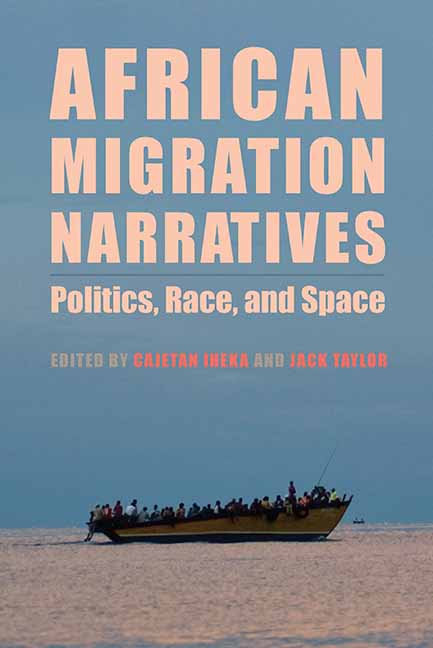Book contents
- Frontmatter
- Contents
- Acknowledgments
- Introduction: The Migration Turn in African Cultural Productions
- Part One African Migration on the Screen: Films of Migration
- Part Two Forgotten Diasporas: Lusophone and Indian Diasporas
- 5 Mami Wata, Migrations, and Miscegenation: Transculturalism in José Eduardo Agualusa, Mia Couto, and Germano Almeida
- 6 Poor Migrant: Poverty and Striving in Nadine Gordimer's July's People and The Pickup
- 7 Reimaging Blackness in a Hybridized and Racialized Space: The Visual Landscapes of the Peruvian District of El Carmen, Chincha
- Part Three Migration against the Grain: Narratives of Return
- Part Four Migration and Difference: Indigeneity, Race, Religion, and Poetry at the Margins
- Bibliography
- Notes on Contributors
- Index
7 - Reimaging Blackness in a Hybridized and Racialized Space: The Visual Landscapes of the Peruvian District of El Carmen, Chincha
from Part Two - Forgotten Diasporas: Lusophone and Indian Diasporas
Published online by Cambridge University Press: 26 July 2019
- Frontmatter
- Contents
- Acknowledgments
- Introduction: The Migration Turn in African Cultural Productions
- Part One African Migration on the Screen: Films of Migration
- Part Two Forgotten Diasporas: Lusophone and Indian Diasporas
- 5 Mami Wata, Migrations, and Miscegenation: Transculturalism in José Eduardo Agualusa, Mia Couto, and Germano Almeida
- 6 Poor Migrant: Poverty and Striving in Nadine Gordimer's July's People and The Pickup
- 7 Reimaging Blackness in a Hybridized and Racialized Space: The Visual Landscapes of the Peruvian District of El Carmen, Chincha
- Part Three Migration against the Grain: Narratives of Return
- Part Four Migration and Difference: Indigeneity, Race, Religion, and Poetry at the Margins
- Bibliography
- Notes on Contributors
- Index
Summary
An image is a mental or visual representation of an entity, idea, or phenomenon. It represents/encapsulates something, but it is not an end in itself. Rather, it points to something else of which it stands as a symbolic connotation. Images constitute an inalienable component of the human psyche insofar as they underlie the way we make meaning of the world; our relation to others; and the social, economic, and political regimes under which we find ourselves. The question of visual representation is crucial to the perception of minority communities that are often relegated, obscured, and misrepresented in mainstream society and media. Peruvian society falls within that category given that in spite of considerable progress in minority representation in that country, “it still has a colonial social stratification where segregation and racism remain as a part of the national identity.” However, the dominant image and imagination of minority groups and their cultures do not go uncontested. With respect to the Peruvian district of El Carmen, this chapter examines how the Afro-Peruvian population engages in visual self-representation in the domains of gastronomy and music to combat denigrating images by the dominant mestizo or Creole population. Given the centrality of the Afro-Peruvian population in the country's music and gastronomic cultures, visual codes associated with these key domains offer far-reaching implications for practices of selfrepresentation. This chapter explores the visual signs of El Carmen's public spheres and house museums that highlight the cultural survival and resilience of Afro-Peruvian community in a culturally hybrid space. Secondly, it examines the cultural impact of black migrants on El Carmen. In order to fully situate the representational significance of the visual representations discussed in this chapter, it is necessary to probe into the racial and historical background of Peru, a society whose contemporary racial and social relationships are characterized by racist ideologies, forced immigration (slavery), exploitation, and marginalization.
Forced Migration and Black Slavery in Peruvian History
In terms of racial composition, Peru is one of the most diverse countries in Latin America.
- Type
- Chapter
- Information
- African Migration NarrativesPolitics, Race, and Space, pp. 114 - 140Publisher: Boydell & BrewerPrint publication year: 2018

